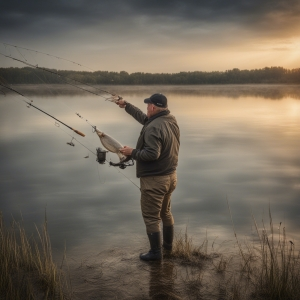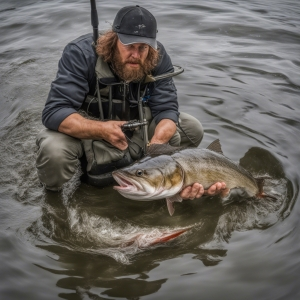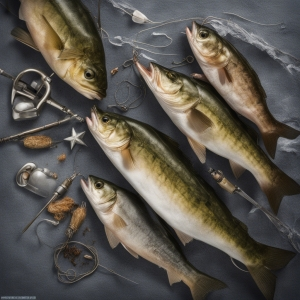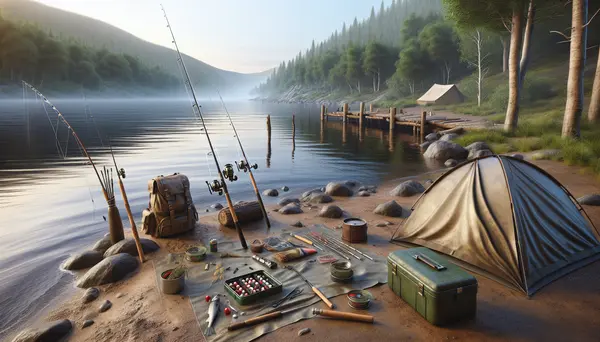Table of Contents:
Fishing Photography: Immortalizing Memorable Catches
Anglers know, there are few things as exhilarating as the moment you land a big catch. But what's even better than telling your friends about it? Sharing a photo of your triumph. This is where fishing photography comes into play. With the right techniques, you can create stunning images that perfectly encapsulate the thrill of the catch.
Whether you're an experienced angler looking to enhance your photo skills, or you're new to the fishing and want to know how to capture those special moments on camera, this guide is designed to provide you with practical fishing photography tips. The goal is to help you transform 'fish tales' into compelling visual stories - ones that capture not just the catch, but the entire angling experience.
So, if the thought of showcasing your best catches in vibrant, engaging photographs appeals to you, keep reading. We will show you the secrets of fishing photography, from the right gear and settings to use, to techniques for capturing the catch at its best angle.
Must-have Gear for Capturing Fishing Photos
Getting those great fishing shots begins with having the right equipment at hand. Here's a quick rundown of the gear you'll need for top-quality fishing photos.
Digital Camera: It should go without saying, but a good digital camera is the cornerstone of fishing photography. Whether it's a compact point-and-shoot or a more advanced digital SLR, the key is to choose a model that can handle the outdoor setting well.
Waterproof Case: Let's face it - fishing can get messy. Protect your camera from the elements with a sturdy, waterproof case. Bonus points if it floats!
Polarizing Filter: With fishing photography, you'll often be dealing with harsh midday light and reflections off of the water. To manage this, consider investing in a polarizing filter. It can help you tame the glare and capture more vibrant colors in your shots.
Swiss Army Knife: A useful tool to have on hand to help with setting up shots, cutting back foliage, or even rescuing your gear if it takes an unplanned dip in the water.
Microfiber Cloth: Stay ready to capture that perfect shot by keeping your lenses clean and smudge-free with a quick swipe of a microfiber cloth.
All these tools will help you take higher quality photos but remember nothing can replace good technique and a bit of creative vision, which we will cover in the next section.
Pros and Cons of Fishing Photography
| Pros | Cons |
|---|---|
| Preserving memories of your biggest catches. | Requires additional equipment and handling, potentially complicating your fishing expedition. |
| Can inspire others and share your experience. | Risk of damaging equipment due to water or accidental drops. |
| Helps in documenting the species and sizes of fish. | The need to quickly take the photo can potentially impact the well-being of the fish. |
| Beautiful scenic photos can be captured alongside your catches. | Can be challenging to achieve good quality pictures in poor lighting or weather conditions. |
Mastering the Art of Angled Compositions

In fishing photography, just as in fishing itself, angles matter. The angle of your shot can make a big difference to how your final image turns out.
High Angle Shots: A high angle means shooting from a point above your subject and directing your camera downward. This can be great for showcasing the size of a catch, or presenting an overall view of your fishing environment.
Eye Level Shots: Eye level shots bring the viewer directly into the scene, engaging them in the moment. In this case, you'll align your camera with the eye level of your subject, showing the viewers what you are seeing.
Low Angle Shots: Low angle shots involve making the subject look larger and more dominant in the frame. You do this by shooting upward from a lower point. This type of shot can help accentuate the size and strength of your catch.
Remember, creating a great composition is about more than just arranging elements within a frame; it's about telling a story. So, use these angles creatively to elicit emotion, add depth and context to your images, and make those fish appear as grand as they felt when you reeled them in.
Lighting And Timing: The Secret to Vibrant Pictures
Nailing the perfect fishing shot isn't just about equipment and framing - the timing of your shot and the quality of light will greatly affect the appearance of your photos.
Natural Light Timing: Photos taken during the early morning or late afternoon are often the most visually pleasing because of the "Golden Hour". This term refers to the time shortly after sunrise and before sunset, when the sun is lower in the sky and its light is softer and warmer. If you can plan your photo session during these hours, you'll likely capture much more dramatic and visually stunning photos.
Overcast Days: Overcast days may seem gloomy, but for photographers, it can be the best lighting situation. The clouds act as a natural diffuser, spreading the light evenly and reducing harsh shadows. It's perfect for capturing rich, detailed shots of your catch without the risk of overexposing parts of your photo.
Positioning: If you’re out in the middle of the day and the sunlight is strong, position yourself (and your catch) in such a way that the sun is behind you. This way, your subject will be properly lit and you won't have to deal with the shadows falling on the subject's face.
Timing: Lastly, don’t rush the process. Wait for the moment when the fish is doing something interesting - leaping out of the water, wriggling in your hands, or glistening with fresh water droplets. These movements capture the liveliness and excitement of the angling experience, giving your photos energy and action.
As you can see, when it comes to fishing photography, the timing of your photos and the quality of lighting have a dramatic impact on the vibrancy and allure of your pictures. So, take advantage of timing, manipulate light, and capture stunning, vibrant photos of your catches!
Action Shots: Enhancing the Drama of the Catch

One remarkable way to illustrate the thrill of your angling experience is through action shots. These are photos that capture the energy, movement, and intensity of the catch, turning your fishing feats into lively, dynamic images.
Here are some tactics you can employ to capture action-packed fishing photos:
Burst Mode: This function allows your camera to take multiple shots in rapid succession. It's a fantastic feature to use when the fish is jumping out of the water or while you're reeling it in. Post-catch, you'll have a series of photos and can choose the one where the action is most dramatic.
Play With Shutter Speed: A faster shutter speed freezes the motion, making everything crisp and sharp. A slower shutter speed, on the other hand, can provide a sense of motion and speed. Experiment with both and see which works best for your desired effect.
Capture the Environment: Include elements of the landscape in your action shots. This not only provides context but also helps convey the whole story of your angling adventure.
Anticipate the Shot: Keep your camera ready, and anticipate the moment of strike or when the fish leaps out of the water. Your readiness can make a world of difference.
Remember, practice makes perfect. The more action shots you take, the more you'll understand how elements like light, motion, and angles intersect, resulting in visually compelling shots that celebrate both the catch and the excitement associated with it.
Post-Processing: Enhancing Your Fishing Photos
Once you've captured your fishing shots, the artistry isn't over yet. The post-processing or editing stage is where you can truly bring your fishing photographs to life. Let's explore some aspects that are important in this stage.
Image cropping: Sometimes, no matter how carefully you frame your shot, there are elements that you wish weren't there. In post-processing, you can crop your images to eliminate unwanted parts and enhance the overall composition of the photo.
Adjusting lighting: Even the best photographs can have uneven lighting. Whether it's shadows, overexposure or underexposure, using editing software can help to achieve better balance in your images. Adjusting brightness, contrast, highlights, and shadows can often result in a much more visually appealing image.
Enhancing color: You might want to boost the color intensity in your photos to make them more vibrant. Adjusting the saturation, vibrance or color balance can help convey the true beauty of your catch and the surrounding natural settings.
Noise Reduction: In low light conditions, your photos may turn out grainy. Fortunately, most photo editing software have a noise reduction feature. It smooths out this grain and gives your photos a cleaner look.
Sharpening: This tool is perfect for bringing out the scales on your catch. Just remember, too much sharpening can make photos look unnatural, so apply it sparingly.
While it’s easy to get carried away with all these adjustments, the goal should be to maintain a natural look in the photos. After all, less is usually more.
Conclusion

Fishing photography isn't just about showing off your catch; it's about telling a story of your fishing adventure. By incorporating these tips into your fishing photography routine, you can capture outstanding images that truly reflect the joy of angling. Like any skill, it requires practice, patience and creativity. So grab your camera, get out there and start capturing those unforgettable moments.
Essential Tips for Future Fishing Photography Enthusiasts
Now that you're armed with knowledge about gear, angles, and lighting, it's time to get to the heart of fishing photography. Here are some crucial tips for those ready to dive into this exciting hobby.
Keep it Real: The real joy of fishing lies in the struggle to outsmart nature. Reflect that in your photos by capturing not just the perfect catch, but also the rig, bait, and the thrill of the fight. Let your narrative be as authentic as the experience.
Stay Patient: Just as fishing requires patience, so does photography. Good shots may not happen immediately. Waiting for the right light or the catch’s best side to come forward requires time, so don’t rush things.
Hone Your Skills: Photography is a skill that needs to be regularly polished. Keep practicing, learn new techniques, play with angles and lighting, and soon enough, you'll see improvement in your shots.
Include the Angler: Don't forget to include the angler in your photos. After all, the excitement and joy of the person behind the rod is as much a part of the tale as the catch itself.
Don’t Neglect Post-Processing: In the digital era, capturing the photo is just step one. Post-processing or image editing can help to refine your shots. Tools like Photoshop, Lightroom, or even simple phone apps can enhance colors, improve clarity, and remove unappealing bits to ensure your photos look their best.
Fishing photography is about more than just showing off your catch - it's about encapsulating your entire fishing journey. So, learn to enjoy the process, take your time, and remember - every picture tells a story.
Master Your Fishing Photography: Tips to Showcase Your Best Catches
What equipment do I need for fishing photography?
A digital camera or a smartphone with a good camera, a tripod, and optional equipment like a waterproof case, polarized lens, and a drone for aerial shots are helpful.
How can I get the best lighting for my fishing photographs?
Try to use natural daylight ideally during the Golden Hour - at dawn or dusk. If that's not possible, use artificial lighting to light up the subject but avoid harsh flash.
Which angles are best for capturing fishing catches?
Experiment with various angles. A bird's-eye view, a side angle, a close-up of the fish against the angler can result in great pictures. The key is to be creative.
Should I use the rule of thirds in fishing photography?
Yes, the rule of thirds can help create balanced, visually appealing images. Place your subject along the lines or at the intersections of the grid.
Any tips to capture the action of the catch?
Use burst or action mode on your camera to capture the catch in motion. Anticipate the action and be ready to capture the moment when the fish breaches the water.







